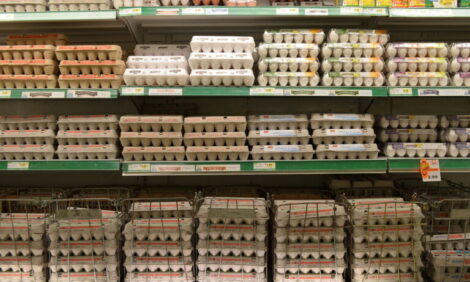



Factors Affecting Water Intake of Poultry
In Canadian Poultry Industry Council's Tech Info 11, Dr John Summers gives some examples of factors affecting the intake of water by hens and chicks.Polydipsia
There have been some strains of birds, and individual birds within a strain, that have water intakes approaching double that of 'normal' birds. While genetic selection has markedly reduced the incidence of such birds, the possibility exists for high water intake of a flock to be genetically related.
A recessive major gene has been suggested as the cause of the problem. Usually there is no difference in performance of 'normal' and these polydipsia birds.
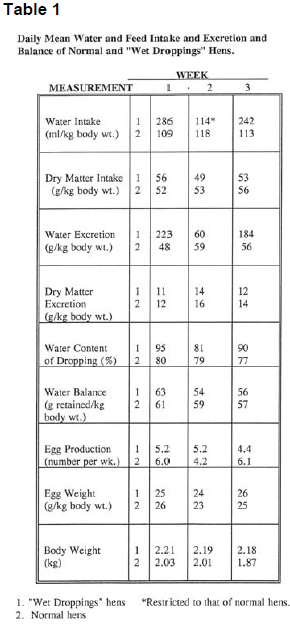 |
Hens producing wet droppings are often noted in a flock. The condition appears to be transient, reversible and usually occurs with only a small number of hens. The condition does not appear to be associated with a particular breed or watering system, nor a change in diet or drinking water.
Lintern-Moore (1972) designed an experiment to study whether wet droppings was the result of an obligatory loss of body water, subsequently compensated for by increased water intake, or whether it is the result of primary or secondary polydipsia.
Seven normal hens and seven 'wet droppings' birds were placed in metabolism cages. They were offered feed and water ad-libitum, with the exception of the 'wet droppings'; birds which were restricted in water intake to a level equal to that of the normal hens during the second week of the 3 week test. Water intake of the 'wet droppings' hens was approximately 2.5 times higher than that of the normal hens with similar body weights and egg production (Table 1).
Restricting 'wet droppings' birds to water intakes similar to the normal hens, did not result in dehydration, body weight loss or change in electrolyte excretion. Thus, it is concluded that 'wet droppings' is a direct result of polydipsia (increased water intake) rather than an increased water intake to counter loss of body water. The reason for some birds to, at times, drink excessively is not known.
Water Consumption as Influenced by Stage of Egg Formation
It has been reported by several workers that water intake of the laying hen is influenced by the physiological stages of egg formation. Nys et al. (1976) recorded water intake of individual hens throughout the day. Their data was presented as water intake over time from the previous oviposition. It can be noted (Figure 1) that water intake was high immediately following the laying of an egg, and stayed relatively high for 12 hours, with another peak at 8 hours past oviposition, then water consumption dropped, but with another peak around 20 hours after the egg was laid. The first peak in water intake takes place after a intake of water during several hours of low activity just prior to oviposition. The second peak would be influenced, in part by 'plumping' of the egg at this time while the third peak place around 4 to 6 hours prior to oviposition. It is obvious that the bulk of the daily water consumption takes place during the first 10 to 12 hours after oviposition. Since most hens lay within a 4- to 6-hour period each day, this means the bulk of the water is consumed in the morning. This should be taken into account when considering watering time and space, especially in hot summer weather.
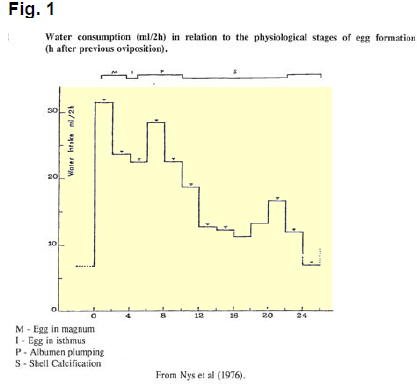
Water Consumption of White Leghorn Chicks
Stahl and Sunde (1983) designed a study to record water consumption of White Leghorn mixed chicks for the first 7 days of life. Two experiments were conducted, each using 900 chicks. Their findings, given as per chick per day, are shown in Table 2. Water consumption almost doubled during the first week of the chick's life. This is an important consideration if birds are being medicated or supplemented through the drinking water.
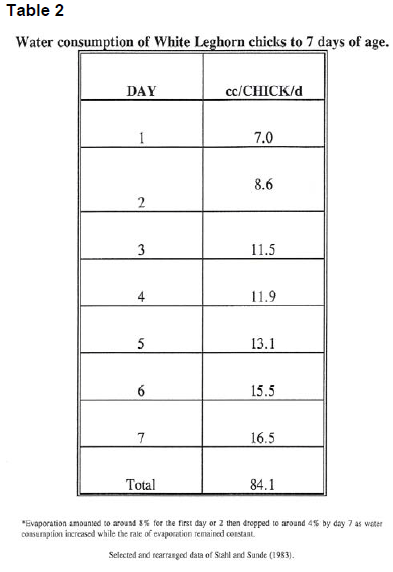
Water Consumption of Laying Pullets at the Onset of Production
Leeson and Summers (1987) investigated water intake of White Leghorn pullets at the onset of production, when fed diets varying in level of dietary calcium. Their data, summarized in Table 3, suggests that the level of dietary calcium is not a major factor influencing water intake or excretion.
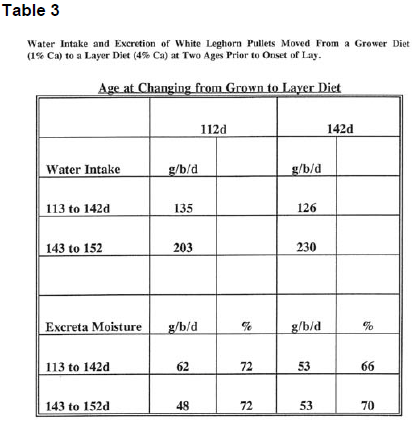
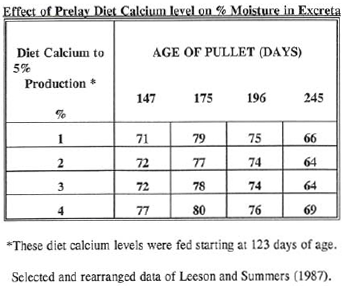
While introducing a high calcium laying diet to pullets at an early age may increase water intake initially, there is no long term effect. Where increased water intake is noted with pullets coming into production other dietary changes, especially protein level, may be responsible for this increase in water consumption.
Water Consumption as Influenced by Diet Composition
That water intake of poultry can be significantly altered depending on diet composition is demonstrated in the report of Patterson et al. (1989) (Table 4). Hens fed a higher fibre wheat middlings diet consumed approximately 50% more water than those fed corn soya diets. While per cent faecal moisture levels were similar, the birds fed wheat middlings excreted over double the amount of faecal dry matter.
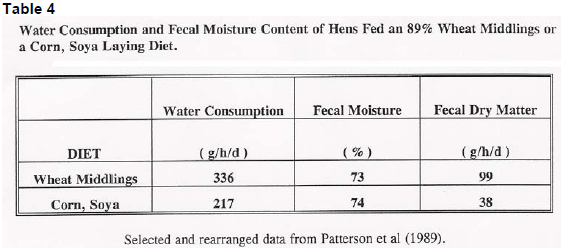
Hence, a significant increase in total moisture excreted would result with the wheat middling diet. While this may not be a problem with birds in cages, much wetter litter would be a problem with floor-reared birds.
Effect of Various Salts on Water Consumption
Adams et al. (1975) reported on the effects of sulphate salts on water intake of White Leghorn hens. Although the results were variable, the data suggested that 4000ppm of sulphate from An2SO4 or MgSO4 significantly depressed feed intake and per cent production (Table 5), with MgSO4 being the more detrimental. On a total salt basis, birds were able to tolerate 4000ppm of either salt with minor deviations from pre-treatment performance. Adding the above salts to water on an equal sulphate basis obviously results in a higher level of supplemental sulphur (Table 5) as compared to similar supplements of the total salts. While the increased sulphur undoubtedly adversely affects the birds, the difference in electrolyte balance resulting from the two different salts obviously contributes to their different effects on performance.
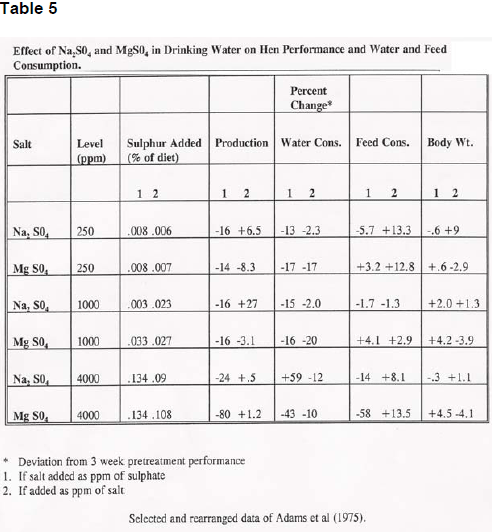
Effect of Adding Sodium Chloride to the Drinking Water of Layers
While the addition of salt to a diet is reported to increase water consumption, of interest is the report of Balnave and Yoseleivitz (1987) where the addition of NaCl to a laying diet did not increase water or feed intake but a marked reduction in egg shell quality was noted (Table 6). However, even with the 600mg/L NaCl supplement, a relatively small increase in total NaCl consumption would occur (approximately 0.14%).
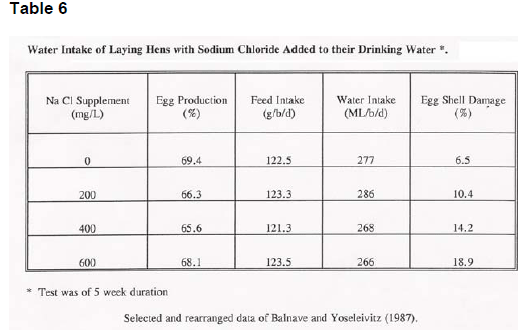
For such a small increase in NaCl intake to result in such a significant reduction in egg shell quality would suggest that a change in acid-base balance, is in turn affecting some critical enzyme system, like carbonic anhydrase, which plays an important role in egg shell formation.
Future Consideration
The importance of optimizing water intake for poultry has to be a very important consideration for a profitable enterprise. Feed intake correlates very closely with water intake up to a level which maximizes performance. Hence, any factor restricting water intake below optimum levels will result in reduced performance. Water acts as a heat sink during periods of heat stress, thus it is essential that the bird is capable of maximizing water intake at such times.
Since water can contribute significantly to mineral intake, depending on source, it is important that intakes of some of the more critical minerals be mentioned. Mineral intake via water, has been given only passing consideration in the past. However, with the change in ration formulation to the use of more additives like essential amino acids, enzymes, probiotics, ionophores etc., which in many cases also add electrolytes to the diets and/or alter the electrolyte balance of an animal, minerals like, Ca, Cl, Na, K, P and S, present in the water supply, may need to be given more consideration in the future.
References
Lentern-Moore S., 1972. The relationship between water intake and the production of 'wet' droppings in the domestic fowl. British Poultry Science 13: 237-242.
Nys Y., B. Sauveur, L. Logossagne and P. Mongin, 1976. British Poultry Science 17: 351-358.
Stahl J.L. and M.L. Sunde, 1983. Water consumption the first week by egg strain chicks. Poultry Science 62: 561-562.
Leeson S. and J.D. Summers, 1987. Effect of dietary calcium levels near the time of sexual maturity on water intake and excreta moisture content. Poultry Science 66: 1918-1923.
Patterson P.H., M.L. Sunde and J.L. Pimentel, 1989. Water consumption and fecal moisture of laying hens fed wheat middlings and corn-soybean-alfalfa meal diets. Poultry Science 68: 830-833.
Adams A.W., F.E. Cunningham and L.L. Manger, 1975. Some effects on layers of sodium sulphate and magnesium sulphate in their drinking water. Poultry Science 54: 707-714.
Balnave D. and I. Yoseleivitz, 1987. The relation between sodium chloride concentration in drinking water and egg shell damage British Journal of Nutrition 58: 503-509.








